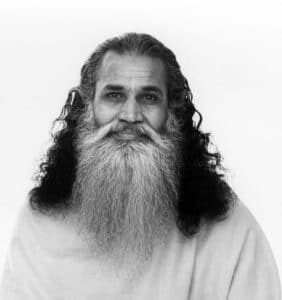In any pursuit, the advice of a master is incredibly valuable for advancing one’s craft and avoiding common mistakes. Yoga master Swami Satchidananda shares practical teachings about one of the most important pursuits we may ever undertake—realizing one’s Self through meditation.
Meditation
The aim of Yoga is to know the truth, which is one’s Self. This knowledge alone can help us to free ourselves from all turmoil and petty mindedness.
We have a tendency to divide people into thousands of names: I am this, I am that. Oh, he is different from me, she is different from me. We group people by their color, by their country, by their race and by their religion; and we kill each other.
All this unhappiness because we fail to see, to know, that we are above all these things. But if you reach into the depths of your own Self, you will find this contentment. By knowing your true nature, you will also know the truth in others. It is in that truth that we come together.
And it is this goal that is expounded, either directly or indirectly, in all the different religions and philosophies. To contemplate these points or to come to this realization within one’s Self is what you call meditation. This realization is arrived at either directly or indirectly, according to the nature of the individual’s practice.
Technique
The technique of meditation is to keep the mind fully occupied on one thing. When the mind is fully occupied on one thing, it is kept away from many things, and it becomes quiet. Then, you find a kind of calmness, and in that stillness even that one thing will slip away after some time.
It’s something like going to sleep. You set aside all your work; you lie down in bed and you might listen to some soft, gentle music. If you really want to go to sleep, you don’t think of anything else aside from the music and after some time, even the music is forgotten.
Meditation is similar, except that we shouldn’t become unconscious as we do in sleep. So, that process of sticking to one thing, concentrating on one thing, will slowly make you raise above that one thing also. In other words, when you concentrate fully on only one thing, that one thing will become nothing (no-thing). Then, you will realize everything by realizing your true Self.
Concentration should culminate in mediation. Meditation should slowly make you slip into samadhi, which you can call the transcendental level. In samadhi, you transcend the mind and body and enjoy your true nature.
The Process of Meditation
Meditation begins with concentration—trying to focus your mind on any one point. I say any one point, because that point can vary to suit the taste, temperament, habit, and faith of the individual. One approach is that of self-analysis. Watch the mind and ask yourself: Whose thoughts are these? Who is worried? Who is troubled? Who is disturbed? Who am I then? How do I know all these things? My knowing doesn’t seem to become disturbed when I know that I am disturbed.
The process then, is to identify with the knower and not with the disturbances in the mind. This is direct analysis. Or, simply be still and watch. Be quiet and watch what is happening in the mind and body. Sitting and watching your thoughts and breath movements, just become aware of the subtle movements within you.
On the other hand, an indirect means of analysis is to take yourself to be the mind: I am disturbed because I am having all kinds of wants. I want this, I want that. Let me resign from everything. Let me offer everything to humanity or to God. You pray, “God, take away these disturbances; give me happiness, give me peace.” Sit and pray wholeheartedly, realizing the full meaning of every word. This also, is meditation.
Another way is neither asking for anything, nor analyzing but just keeping the mind on one point. This point, or object of meditation, can be either a sacred name, a mystic mantra, the cosmic syllable OM, or Amen, OM Shanti, Hari OM, etc., or it can be a form. As there is no particular form of God, you can approach God through any form you wish. If you concentrate on a physical, concrete form—Jesus, Buddha, Siva, or Krishna—after a time, you can create a mental picture of that form. Or, if you do not want a particular human form through which to worship God, then you can have a visual image of the sun, the moon, the stars. You can see God, you can approach God in any way or form you like, because God is present everywhere and in every form.

Swami Satchidananda
When you are trying to keep your mind on that point, whether it be an idea, a word or a form, you will often see the mind running here and there. Whenever it runs and you become aware of it, bring the mind gently back to the point. In another few minutes, it might run to another idea; bring it back. This constant effort of bringing the mind back, again and again to the point, is what you call concentration. In Sanskrit it is called dharana. You have not fixed the mind yet; you are trying to fix it. If that fixing of the mind becomes a little longer, then you are approaching meditation. When concentration becomes perfect it is called meditation. But don’t think that you are wasting your time if your mind is not fully controlled. No one has ever achieved meditation right away. I come across many people complaining, “My mind runs here and there; how can I meditation?” That is the process of meditation.
Excerpted from the short book, Meditation, by Swami Satchidananda.



